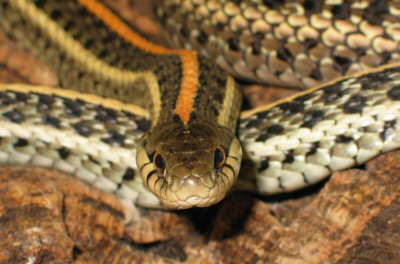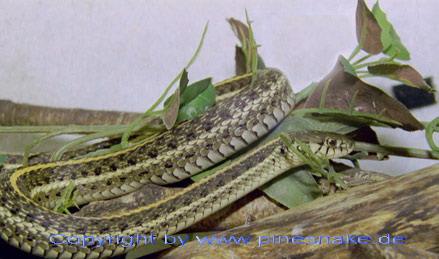|
Besucher:

|
www.pinesnake.de
|
|
|
|
last changes: Sunday, January 06, 2008
|
Keeping and Breeding of the Praerie Garter Snake
Thamnophis radix
|

|
|
|
Description |
|
The Praerie garter snake comes from the USA to us. From Illinois to Texas it occures aproximatly. Often its habit is close to lakes and other water, but too there are animals far up off water found. The males grow up to aprox. 50-60 cm total lenght, females somtimes get a little over 1m. The mid dorsal stripe is from yellow to a colorful orange. The both side stripes are yellow and are on the 3. and 4. scale row. The animals have a dark head and on the back there mostly is a chess board related marking of black spots on a olive ground coloration. In some populations the ground color is so dark, that the black markings are washed with the ground color in a solid black (f.e. Iowa). But the yellow and orange stripes are wonderful visible in this coloration. The belly mostly is a washed oliv with little black spots.
|
|

|
Years ago this genus were seperated in ssp. radix (Eastern radix) and haydeni (Western radix). Nowadays the haydeni is only a colorvariant of T. radix radix. Those haydeni mostly are animals with a dark ground color and a nice orange mid dorsal stripe. They have 21 or more midbody scale rows and 155 or more belly scales. The other radix have only 19 scale rows in midbody and maximum 144 belly scales. The haydeni-phase occures in Iowa and Illinois. In the border area of those phases there often are found „intergrades“ with mixed details.
|
|
Keeping and Behavior
|
|
In terraria they prefer temperatures between 24 and max. 30 °C, above this they become very stressy. My snakes are agil and interesed in all new. The males mostly are a little more shy and afraid of all than the females. All my radix females are hand tame. For the keeping of adult radix a 1m terrarium is not to much, smaller ones grow up in pet-boxes. As ground gravel I prefer hacked wood pieces (for smoked meat and fish, when it burns). One danger with this material is, that it can be eaten with the food and can do hard damagings in the body. Other gravels from the terrarium suppy is useful, too. But one problem is the exessiv bathing sessions of these snakes, wich can wet the gravel heaviely. In the terrarium are some branches, wich are used for klimbing or laying regulary. On the grond there are some greater pieces of cork bark for hiding places, but most of the time the animals are active or lie open in the enclosure. For a water bowl I use an open plastic box with aprox. 3l clean!!! water in it. The rest of the terrarium is dry. They use the waterbowl regulary and so the sheding is never a problem. My Thamnophis radix live since several years together with the banded Florida water snake (Nerodia fasciata pictiventris). In the same lenght it is never a problem, but with the time the females of the fasciatas can grow up to more than 1 kg. And than the small males of the Thamnophis have a problem ;-). But til now I never lost an animal in this form of keeping.
|
|
Diet |
|
My animals get defrosted fish two times a week all together in the terrarium. These are little complete fresh water fisches (German: Stinte) and I feed them in one piece. Greater fishes I cut in pieces. After defosting in warm water I put those fishes in a bowl (without the water) and put it in the terrarium. My animals never got a live fish in my terraria, but this form of feeding is possible, too - but it makes a lot of work! radix like to eat small and medium sized mice very much, too. My animals leave the fish, where it were and trie to get the defrosted mouse. I add to the food alternating „Multivitamin-B-Komplex-Preparat“, next time nothing, than a „Multivitamin-Preparat“, than nothing again. In spring I add sometimes food chalk powder to the food to help the mothers to produce well developed young snakes. All those additives never disturbed my animals in feeding and they are under best health conditions for years. Small fights are regulary in feeding, but never one of my Thamnopis/water snakes were seriously hurt by this.
|
|
Hibernation |
|
In habitat the winter often are long and hard and those animals hibernate for several month. In terraria this animals should hibernate for 2-3 month at 5-15°C. Too, for the fathering ability of the males it is sometimes nessesary, but there occured birth of young without hibernated snakes (males). My snakes hibernate in the terrarium for 8 weeks at aprox 12° and in every year my snakes got healthy young.
|
|
Reproduction |
|
After the hibernation it can be positiv to awake the males at first and higher their ilumination durination and heating. After fist feedings you can awake the females. After this I put the females to the males and sometimes some hours later the first copulations were sighted. If they awake togeter after hibernations the matings occure some weeks later. When the female begin to eat, I feed all animals up to 3 times per week, so that all get strong again and the mothers get power to be pregnant. The females slowly get bigger and aprox. 2,5-3 month after copulation they give birth to their babys. In my terraria I had between 20 and 61 babys per mother. In literatur you can find births up to 80 babys. With the amount of the babys the size of every one decreases normaly. If possible, you should set the females short before the birth in a single stressfree terrarium. And: There were some seldom cases of canibalism in Thamnophis... My snakes stay together all the year (inclusive the Nerodias), and I never lost any Thamnophis babys because of canibalism of the greater snakes. Other people had not so much luck.
|
|
Young Snakes |
|
After birth I catch the small snakes carefully off the terrarium and put them in groups of 10-20 in small boxes. I start with moist paper towel to help the animals in sheding. Some days later I change the towel for wood shaving or straw-gravel. The boxes are sure for outbreak, that is important. With a wet belly they can climb up screens! The cloration is similar to the adults and the lenght is between 10 and 20cm. After 3 or 4 days I begin to feed with a bowl of cutted small fishes. Most of the small Thamnophis start feeding in the next days. The further rearing is without problems, I feed all 2-3 days and add vitamins as in adults. Canibalism never occurs in my rearing. Smaller shy snakes are better keep together. The stronger snakes sometimes molest them and they stop feeding. In increasing lenght I make the groups smaller, now 5 animals ar enough for a box. Some males reaching so in next spring the mating age!!! But there are allways some small snakes, wich never ate anything. They can be forcefeed by very calm and friendly herper - or die in 1-2 month.
|
|
Maturity, Lifespan |
|
Some males copulate with an age under 1 year, the female normaly need mimimum 2 years to get mature. These snake normaly only get a little older than 10 years.
|
|
My Snakes |
|
At this time there is no radix in my terrarium left - but maybe I begin again one day.
|
|
Commendable Literatur |
|
All in German, but there are several good books about the genus Thamnopis in Englisch, too ;-)
|
Strumpfbandnattern from Hallmen/ Chlebowy from the NTV-Verlag
|
very commendable
|
|
Strumpfbandnattern from Mutschmann from the Neuen Brehm Bücherei
|
good
|
|
Strumpfbandnattern from Mara from the Bede-Verlag
|
cheap and colorful
|
|
|
|
A lot of habitat information you can get in the field guides, wich are named in the page -Books- in the main navigation.
|
|
|
|
|